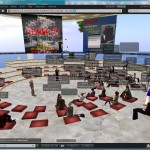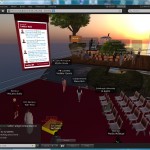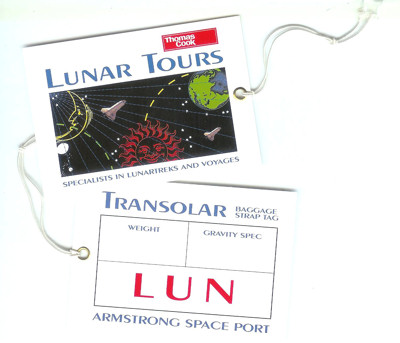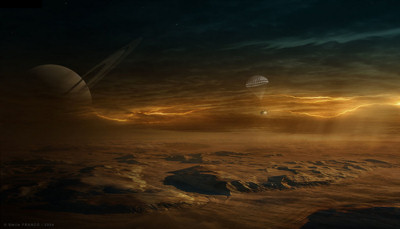Archive for October, 2011
Aldebaran Nau Demo in Edinburgh
Posted by Austin Tate in EDC11 on October 13, 2011
The Aldebaran Robotics Nao European Tour for educators was in town today, and I went along to see the robot and its software interfaces being demonstrated.
Life Wall Pro – Places as an Anchor for Life Events
Posted by Austin Tate in EDC11 on October 11, 2011
I am continuing to explore ideas in using my “Life Wall” for professional and academic purposes, such as presentation of a scientist’s thematic contributions and achievements. I have been testing out ways to describe professional life events as “Placemarks” described in KML and to add them to Google Earth or Google Maps.
An example on my Life Wall Pro version with some locations I have current profesdsional contacts with is at: View Life Wall Pro – Google Map Element
Some background to the XML used for KML Placeholders is here:
https://www.wiki.ed.ac.uk/display/Informatics/Google+Maps+Placeholder+in+KML
Exploring the EduNation Regions in Second Life
Posted by Austin Tate in EDC11 on October 11, 2011
This is a mixed use and mixed institution educational area, with a number of plots used by a range of Universities, coverages and academic groups. There are a number of “classrooms in the sky” on various levels.
- http://maps.secondlife.com/secondlife/EduNation/219/231/74 (Castle to Overlook the Region)
- http://maps.secondlife.com/secondlife/EduNation%20III/136/127/900 (High Dive Platform)
On arrival and initial exploration, the area is not well described or signposted. There is no obvious entry/arrival area and no note cards are offered. Looking round though it was clear there were specific institution and class areas set up for specific subjects. A veterinary studies area had sculptures of horses, and posters and displays related to horse anatomy for example. It had some nice teaching and presentation aids. There was a nice interactive “Artboard 2.1″ using prims for marked lines.
To find out more about the area and its uses, a Google search on “EduNation Second Life” leads to http://heyjude.wordpress.com/2007/02/05/edunation-secondlife/ which has next to no content and no one has posted comments… it’s full contents are:
The Consultants-E are proud to launch the first private island simulator in Second Life dedicated to online training seminars and conferences, and the use of Second Life in Education. EduNation is a 65,000m2 island in the Second Life virtual world with seminar, powerpoint, audio and videocast facilities. Use of the seminar facilities is free. More information at EduNation (http://www.theconsultants-e.com/edunation/edunation.asp)
That URL leads only to “Server Error – 404 – File or directory not found. The resource you are looking for might have been removed, had its name changed, or is temporarily unavailable.
This is rather typical of educational regions that are not well managed or owned by specific stake-holders. The area should be considered as one that lets people set up individual classrooms and areas and is not meant to have a cohesive design or allow for random exploration and discovery.
A good example of it in productive use by educators, and the reason I chose this region to explore, was a recent demonstration of a new version of the SLoodle module for the Moodle Victual Learning Environment. The demonstration organisers set up a new area well up in the sky and rafter landing at a simple initial meeting space, they dynamically rezzed large platforms nearby to show the facilities. and even rezzed a bridge to let the visitors walk over to that newly created facility. I attended a briefing about the new SLoodle 2 toolset on the EduNation III region of Second Life on Sunday 18-Sep-2011 by Paul Priebsch (avatar name: Fire Centaur). About 30 other educators were there. A feature of SLoodle 2 is the ability to set up “scenes” an rapidly rezz them in and around a classroom for a lesson, and then tidy them away so the ability can be re-used. This was demonstrated live on the EduNation regions. The SLoodle quiz chair can be set up to give rewards to students, or “penalise” them for failure… including dumping them in a shark filled pool with realistic screams!
A blog report of that demonstration is at http://holyroodpark.net/atate/weblog/6149.html. Full size versions of some images of the demo meeting are gathered at http://openvce.net/sloodle
AI – Avatar Identity – Digital Artifact
Posted by Austin Tate in EDC11 on October 10, 2011
Ai & Be – Avatar Internet Chat
Design rationale, background, video, extended artifact and live artifact visiting details: http://atate.org/ai/ai/
Avatar to Avatar Chatbots
Posted by Austin Tate in EDC11 on October 9, 2011
My two avatar MyCyberTwin OpenSim chatting away together in OpenSim. Part of an exercise for the Digital Cultures EDC11 Digital Artifact exercise:
http://atate.org/ai/ai/res/2011-10-09-chat-log-ai-and-be.txt
At least they don’t bicker like some recent chatbot to chatbot chat experiments: http://www.youtube.com/watch?v=WnzlbyTZsQY
Fast, Far, Forever
Posted by Austin Tate in EDC11 on October 8, 2011
I have always been fascinated by fast cars, advanced planes and spacecraft and there is a thread running through my interests which I have been able to explore while creating my “Life Wall” – http://atate.org/ as part of the MSc in e-Learning Digital Cultures course – so this blog post fills in some background.
Fast Cars
Many members of my family have been involved in
motorsport at a number of levels, and I got the bug early on. I had a scrambling
motorbike that we used in fields adjacent to our house in Knottingley, West
Yorkshire, and later developed a drag racing sprint bike that we raced at Ricall
aerodrome on Drag Racing weekends with the North of Britain based British
Quarter Mile Association (BQMA). I was already a rally car navigator for my
older brotherSon local De Lacy Motor Club events before I could legally drive
myself. I can read a map as if its a 3D model laid out before my eyes. We were
taught to drive by my dad in our field and on local aerodromes, and I used my
brother’s (fast racing) go-kart a few times. Scary to be that close to the
ground at nearly 100mph. I passed my driving test almost as soon as I was 17,
joined the De Lacy Motor Club and competed in local rallies and driving test and
motorcross, and I have a few trophies to show for the effort.
But my interest in fast cars and vehicles went beyond that. I loved the engineering cutaways shown in the “Eagle” comic each week, and I followed a number of UK and US Hot Rod and Drag Racing communities via magazines. I was lucky to be taken by my elder brother to see the first visit of the US Drag Racing Team to the UK, who brought over the dragsters then just touching 200mph from a standing start in a quarter mile sprint. Don Garlits, Don Prudehome, Tony Nancy and the other famous racers of the 1960s were all there when I saw a 200mph run at RAF Woodvale in Lancashire. I was an avid followers of the fascinating battle for the land speed record in the US between Art Arfons and Craig Breedlove as they went through 400mph, then 500mph and then 600mph in the space of a couple of years. My dad took us over to see Donald Campbell doing some of his trials runs on Coniston Water in the UK Lake District. I continue to follow the more recent land speed records attempts and have been a supporter of Richard Noble and Andy Green’s supersonic record car in 1997 with my name being carried in certificates in the car as it did its runs at Black Rock Desert in Nevada. I now support the new Bloodhound SSC car being designed to do 1,000mph. My name will be on its tail.
Fast Planes
The early 1960s were a good time for those
interested in fast planes and supersonic or hypersonic travel – with the X-15
rocket plane able to do hundreds of flights straight up into space and back on a
ballistic trajectory. We are only just getting back to the time that will be
reasonably feasible again with Virgin Galactic’s SpaceShip Two. Though it was
not something that was known about to the general population in the 1960s, it
later transpired that the SR-71 Blackbird was routinely flying at Mach 3 or more
for many hours on high altitude spying and scientific missions since the 1950s.
I still find the SR-71 the most beautiful aircraft and take every opportunity to
visit one in the museums around the world as I travel. And I take one for a spin
any time I can in Flight Simulators.
Far Space
So with these interests, its not surprising I
was also interested in space. I was interested in space before sputnik flew, and
already had (and still have) a well thumbed copy of Patrick Moore’s “Boys Book
of Space”, with pencil drawings of the features of the moon in the back from my
pre-teen years. I lived through the early Space Race years, and have my
collectors cards that went from Sputnik up to visionary deep space probes and
talk of a “Grand Tour” of the solar system which I loved the idea of. It would
be some years before my AI planning software was used by NASA JPL as a basis for
Steve Vere’s Deviser planning system that would (after its launch) model the
activity of the Voyager spacecraft which actually flew this Grand Tour mission,
and continues to send tweets which I receive each day of its position far beyond
the Solar System edge.
I have ready to use luggage labels (issued for promotional purposes) when I registered my interest in Thomas Cook flights to the Moon!
I am a Fellow of the British Interplanetary Society which is a fantastic way to stay in touch with space related activities as an amateur. But I have also worked professionally with the European Space Agency consulting on autonomous spacecraft, and worked on projects with them on planners for the ERS-1 spacecraft and a system for assembly. integration and test of Ariane launchers. Our work at AIAI has also fed into telecommand systems for EUMETSAT metrological spacecraft and for ground station planing for the UK Skynet observation spacecraft.
One thing we have found to be a great way to stay in touch with missions has been to place our name on lists carried on CDs, chips or plaques on board exploration spacecraft. We have had our names on the Opportunity and Spirit rovers now on Mars, and our name was carried on a chip on-board the return capsule on Stardust sample return mission to Comet Temple 1. The chip should be in the Smithsonian museum in future. Our names were also on the Deep Impact comet penetrator mission. Our names and photos (and those of my virtual world avatar after an invitation from a NASA Colab group I am part of in Second Life) have flown on each of the last flights of the Space Shuttle in the last 12 months. Unfortunately, we just missed seeing one launch while in Florida after a launch scrub, but did visit and see the penultimate Space Shuttle Discovery on its pad at Cape Canaveral. But in the past we have seen two shuttle launches. And we will shortly be off to Mars again on the new Opportunity Mars Exploration Lab.
Forever – To infinity and Beyond
But perhaps the one I
find most interesting, is that our names and a poem I wrote were carried
alongside other digital artifacts on board the European Space Agency’s Huygens
Titan lander taken by the Cassini spacecraft to Saturn. All contributors were
provided with a copy of the whole set of artifacts by ESA when the content were
completed before launch. We followed that whole mission. Huygens drifted down
through methane clouds gently to land in soft terrain on the shores of a liquid
methane lake overlooked by the rings of Saturn through a hazy sky.
Drift down through the clouds… We’re with you.
Swing slowly on the parachutes aloft…
Our names now stand by that methane sea, at a point in the solar system beyond the distance where the Sun will eventually grow in its red giant stage and consume the Earth. To infinity… and beyond…
Lifestream Week 3
Posted by Austin Tate in EDC11 on October 7, 2011
The White Screen of (Slow) Death
The week was characterised for me by being on travel and working with mobile devices and a slow 3G connection. It is a time to remember that not all our students and distance learners are on fast broadband networks, and every item of content, image and thumbnail download and reload for trivial clicks must be paid for. I experienced blank white browsers screens for over a minute while typical content management systems like WordPress composed their page for rendering… made up of hundreds of images and user icons.. and then showed it all at once.. immediately followed by some click to get you really where you want to be (like login prompt) followed by a total reload of every one of the same content items. These systems are poorly designed for bandwidth limited connections, mobile devices and so on. The systems seem not to have provided fall back styles, and forgotten the art of low bandwidth images, progressive rendering of pages with image and tables sizes predefined, etc.
Twitter, Discussion Forums and Blogs
My life stream this week indicates I can continue to interact reasonably well with others I collaborate with via Twitter while on travel. Though not having a simple way to view new tweets to #tags is an issue… only supported in systems I have with TwitterDeck on my desktops. Threaded discussion Forums are easy to follow, keep up to date with and input to, they can be looked back over indefinitely, searched, and new posts can easily be seen. I would say should be a preferred mode of operations for distance educators. Skype is okay if permitted in your location, but is bandwidth hungry, needs a 100% time connection (3G can drop out frequently in low signal areas), but not ideal for some topics that do not require synconicity. Blog posting are possible, but massive over use of images, header images and so on make this an expensive and time consuming frustrating process for the distance learner or user.
Reading and Comments
I did manage to get on top of core readings for my MSc in e-Learning modules and do some of the secondary reading. That was useful to interact with other students. It allowed for a bit of fun on the Digital Cultures course Skye chat this week, where one of the core reading authors was present. I was half serious about my comment on “tabloid headlines” for phrases such as “uncanny” environments and “hierarchical violence”. But “strangely” and in “uncanny” way I find myself using those phrases as I start to look at a visual artifact for week 4.
@ – THE symbol of Digital Culture
Posted by Austin Tate in EDC11 on October 6, 2011
@ is perhaps the iconic symbol of digital culture and computer use. More so even than the ubiquitous “www.”.
The @ symbol we all use in e-mail came about very early on in the development of computer networks and inter-personal collaboration. In fact it was used on some of the very first Digital Equipment Company (DEC) Programmed Data Processor (PDP) machines (DEC PDP-10s) that were connected together to form the ARPANet around 1969. ARPANet was the predecessor of today’s Internet. Ray Tomlinson working at BBN (who built some of the packet switching systems that form the basis for the Internet) extended a local single computer programme which left messages for other users so you could pass messages between nodes on ARPANet by addressing a user with user@host.
The Edinburgh AI Department ran the DEC PDP-10 for the UK AI community which was connected to the ARPANet. As a PhD student in 1972-1975 I used the local PDP-10 and one at Stanford for my research work in AI planning, and I recall using the send message program and user@host frequently to leave messages for other AI planning PhD students I collaborated with such as Gerry Sussman at MIT and Earl Sacerdoti at Stanford University.
See for example http://inventors.about.com/od/estartinventions/a/email.htm.
The @ (“at”) symbol though does have quite a history and goes back far earlier than the internet and the emergence of digital culture, see http://email.about.com/cs/emailhistory/a/at_history.htm.
Who is Me, My Avatar and His Clone
Posted by Austin Tate in EDC11 on October 6, 2011
Experiments with avatar cloning facilities as a basis for non-player characters (NPCs) in the latest development versions of OpenSim… for a possible visual artifact as part of the MSc in e-Learning Digital Cultures Course.
Through the Keyhole
Posted by Austin Tate in EDC11 on October 5, 2011
I am travelling this week and in a location with no broadband or desktop computer. When travelling like this, I usually use a mobile device and 3G wireless access and limit myself to basic e-mail and a few low bandwidth browser operations. I make notes and lists of things to do on my return. But the period of absence from Edinburgh was longer than usual this time, and thing can start to build up quickly. After a few days I find I am spending longer making notes on what I must do when I return than actually working on something productive.
The (lack of) speed and (lack of) screen real estate becomes a serious problem for much of the type of work I do, but this week that was made more acute with the types of web pages and visual material in use on the MSc in e-Learning courses. The typical type of web page served by a CMS like WordPress, Drupal or Joomla, and even Twitter, is filled with images, thumbnails, and other bandwidth hungry elements, and if usually designed with style layouts which do not allow for progressive rendering. A blank page is offered while many many elements download and then the page appears some time later. These sorts of sites are almost unusable on a typical 3G connection independent of screen size… and this becomes especially frustrating if this is the bulk of the material being accessed.
I quickly developed a sense that I was peering at the world through a very small key hole.






